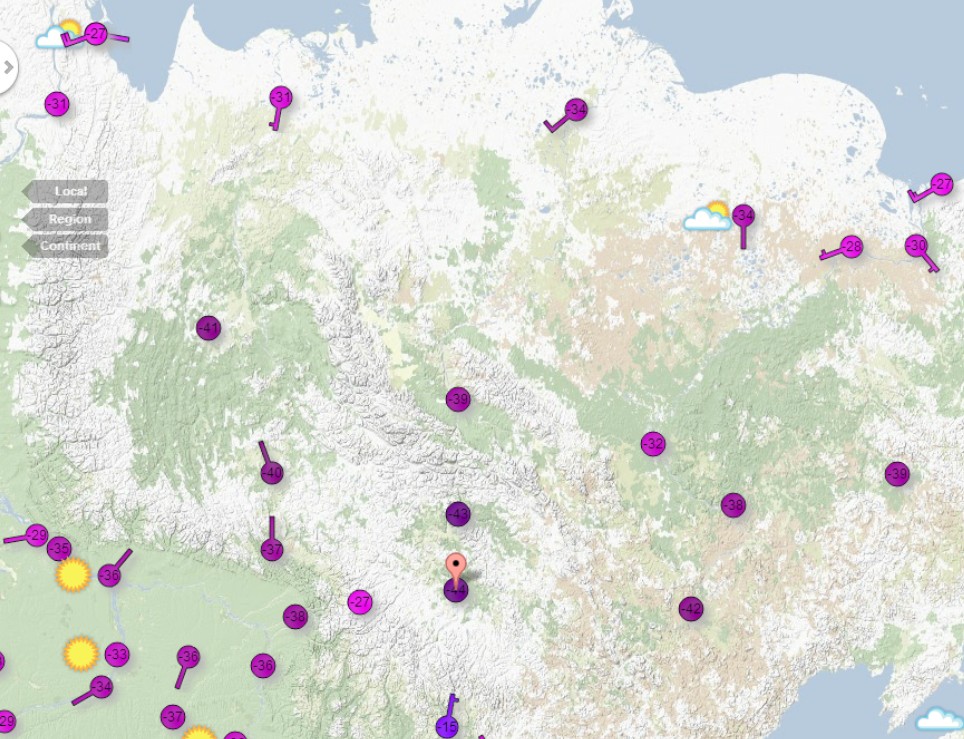DOHA, Nov 27 (Reuters) – Permafrost lands across Siberia and Alaska that contain vast stores of carbon are beginning to thaw, bringing with it the threat of a big increase in global warming by 2100, a U.N. report said on Tuesday.
A thaw of the vast areas of permanently frozen ground in Russia, Canada, China and the United States also threatens local homes, roads, railways and oil pipelines, the U.N. Environment Programme (UNEP) said in the report which was released at the U.N. climate talks being held this week and next in Qatar.
Global Warming Threat: Permafrost Thawing Across Siberia And Alaska Poses New Concern, UNEP Reports
Temperatures in Siberia are running thirty to fifty degrees below zero, which represents ideal conditions for a massive meltdown and release of hot air from Doha.
WunderMap® | Interactive Weather Map and Radar | Weather Underground



Hey, since carbon is in virtually everything we use and consume, and since carbon is an integral part of all life on earth … if we ban carbon we’ll all die and liberals won’t have to worry about people shooting other people with guns. The liberal logic is sound.
On a side note … the Vulcan High Council has banned Vulcans from any contact with earth liberals.
The colder it gets the faster the ice will melt! I have started keeping my ice cream in the oven set at 350F because I like it well frozen! 🙂
“Permafrost” is a terrible misnomer, so much so that few other single terms have caused more widespread public misunderstanding. Go with a video crew into any major metropolis in Europe or the U.S. and ask people on camera what happened when forest fringed the Siberian Arctic during the Holocene Optimum in terms of the devastation caused by the melted “permafrost.”
A better term would be “frequentfrost,” “oftenfrost,” or “sometimefrost” — or maybe just “frost.”
“Greenhouse” effect is another terrible misnomer.
Much of the frozen permafrost is frozen peat bog
http://www.newscientist.com/article/mg18725124.500-climate-warning-as-siberia-melts.html
“THE world’s largest frozen peat bog is melting. An area stretching for a million square kilometres across the permafrost of western Siberia is turning into a mass of shallow lakes as the ground melts”
In the UK peat bogs are considered carbon sinks
http://news.bbc.co.uk/1/hi/sci/tech/6502239.stm
“Healthy peat absorbs and stores carbon; but as it degrades, the carbon is released, ending up in the atmosphere as carbon dioxide.”
So if the frozen peat bogs in the arctic were to melt they would absorb CO2??????????????
These DOH!-A nincompoops expect it to be always below freezing above the Arctic circle?
As long as the peat remains frozen it will not release methane or co2, but it is a deep frost, and summer thaws normally do not extend to the full frost depth(probably never in recent geologic hist.).
Like all the climate variables it’s cyclic, and nothing new, as Harold Ambler points out above.
http://feeder.gina.alaska.edu/feeds/webcam-uaf-barrow-seaice-images/movies/current-3_day_animation.mp4
The Sun is really doing a number on Barrow, AK
Eurasian snow cover has been normal to above normal since October. No sign of any great meltdown, except in the delusional minds of alarmists.
We get permafrost most winter mornings, but it often unpermanents by noon.
Permafrost Far More Stable Than Claimed…German Expert Calls Danger Of It Thawing Out “Utter Imbicility”!
http://notrickszone.com/2012/12/01/permafrost-far-more-stable-than-claimed-german-expert-calls-danger-of-it-thawing-out-utter-imbicility/
‘By the year 2100’ is the new plausible deniability. Close enough to sound real, far enough to avoid embarrassment of being wrong.
Lots of things have changed in the last 12,000 years.And today suddenly change is not normal anymore. How things change!
The other prerequisite for peat to degrade and release CO2 is that it shall dry out. The peat bogs in UK and Ireland (and anywhere else I suppose) are stable until the bog is drained – for example when the 1000 tonnes of concrete are being put in place for a wind turbine.
Trees, moss, bodies etc remain stable in a peat bog for thousands of years so long as the bog is water logged. Eventually it becomes coal – nasty.
About the title: Permafrost isn’t just made of ice so it doesn’t melt: it thaws. Ice melts.
ZZZZZZZZZZZZZZzzzzzzzzzzzzzzzzz